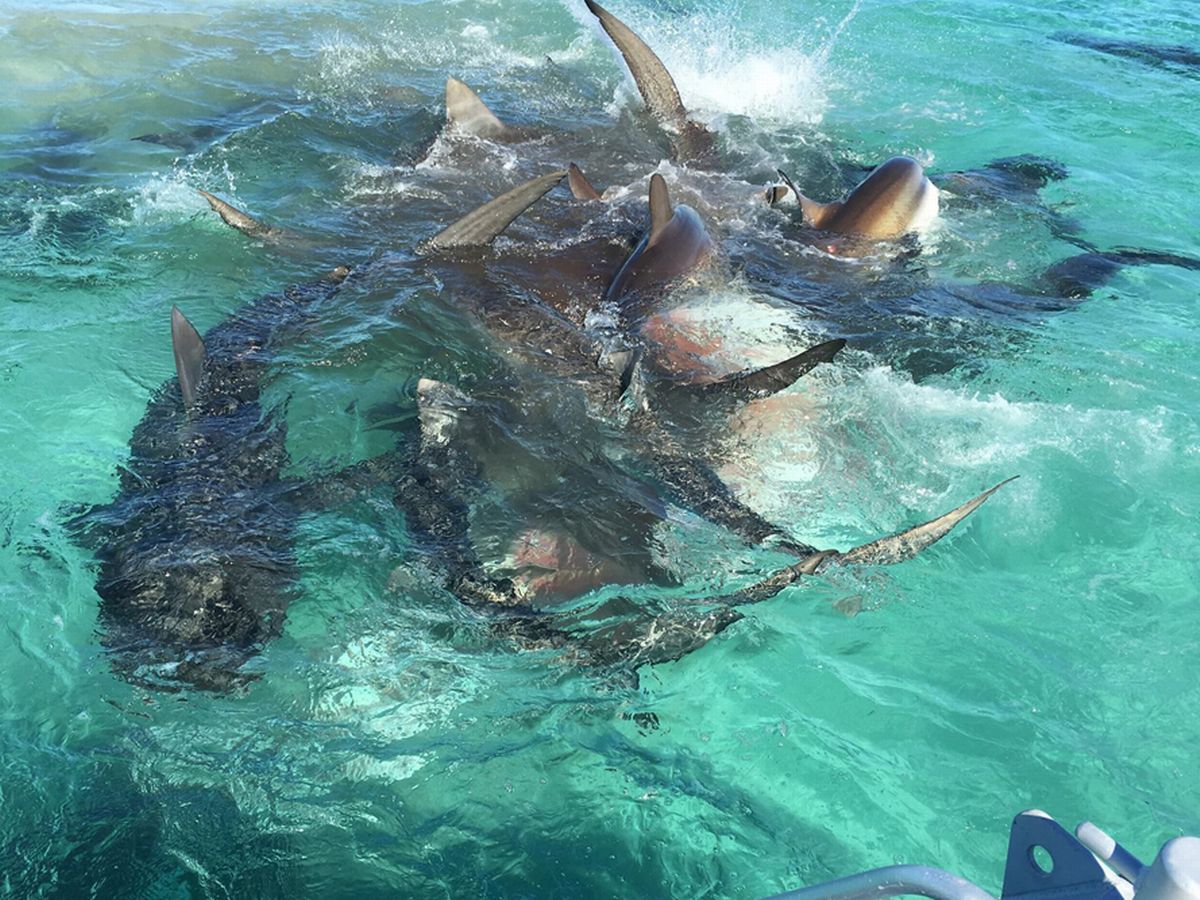All species in the animal kingdom must find food to survive. For some species, finding food can be difficult and energetically taxing. Sharks, in particular, expend large amounts of energy when chasing and procuring prey. In some instances, sharks will resort to scavenging on dead prey, such as whale carcasses, to fill up and restore energy. In fact, one feeding session on a whale carcass can sustain a great white shark for up to ten days!
Finding a whale carcass in the open ocean presents a unique opportunity for scientists. Many different species of sharks are attracted to the free meal, giving researchers the chance to observe feeding habits of these animals that are otherwise difficult to observe in the wild. In this study, a dead sperm whale was discovered on April 18, 2017 in the Seychelles. Scientists used this opportunity to observe foraging shark behavior and calculate species richness, community structure, and cross-species interactions between the foragers.
Methods
Upon discovery, the whale carcass was moored at the surface to prevent sinking and allow observations to be taken. High resolution footage was captured via drone and underwater gopro footage. In addition to video footage, direct observations were recorded by scientists on a research vessel 100m away. Length of the sharks were calculated based on the drone footage by using a pixel-to-meter conversion. Sharks were categorized based on size: small (TL<2.5 m), medium (2.5 m <TL< 3.0 m), and large (TL > 3.0 m). Duration and mode of feeding were recorded based on drone footage. Intra- and inter-specific interactions (i.e. sharks interacting with individuals of the same and different species) were also recorded. No data was collected at night.
Results
The highest number of sharks observed in the drone footage at one time was 14 – one bull shark and 13 tiger sharks. On average, 5-6 tiger sharks were usually found surrounding the whale carcass. Tawny nurse sharks aggregated below the carcass, feeding on falling carcass and skeleton. Although common in the area, no grey reef, sicklefin lemon, or silvertip sharks were seen at the whale carcass.
A total of 78 feeding events were recorded. Of these, 75 were performed by tiger sharks and 3 by bull sharks. 77.6% of feeding events occurred on blubber, 12.9% on pectoral fins, 7.1% on bone, and 2.4% on organs. The average duration of tiger shark feeding events was 18.8 seconds, and 9.3 seconds for bull sharks. Typically, larger sharks fed for longer durations.
Surprisingly, no aggressive inter- or intra-specific interactions were recorded; all sharks scavenged calmly. Bull sharks fed less often than tiger sharks, and were seen giving way to tiger sharks on multiple occasions. Left-right jerking motions with the head, called saw biting, was the most common feeding behavior observed.
Discussion
The presence of tiger sharks around the whale carcass was surprising to scientists, because in over 5 years of research in this area, no tiger sharks had been observed. Because tiger sharks are highly migratory, it is hypothesized that the individuals present at the whale carcass traveled from areas much farther than the Seychelles.
The shape of the tiger shark’s teeth may have led them to dominate the carcass over both the bull sharks and tawny nurse sharks. Tiger sharks have curved, serrated teeth that are better suited for biting off large chunks of flesh. In contrast, bull shark teeth are better for piercing, while tawny nurse shark teeth are more suited for grinding. The discrepancies in teeth shape made tiger sharks more efficient at feeding on the carcass, explaining the higher instances of tiger shark feeding compared to the other species present.
The absence of locally abundant shark species may have been a result of the large aggregation of large sharks. Smaller shark species may have avoided the area in order to lower risk of predation by tiger sharks.
Why does it matter?
Marine scientists are often presented with a unique problem that terrestrial scientists rarely encounter: inaccessibility. It is difficult to observe animals in the ocean, because in many cases, scientists are unable to locate the animal of interest, let alone reach deep depths and remote locations. Therefore, when an opportunity to observe marine animals in their natural environment presents itself, it only makes sense to take advantage. In this instance, scientists were presented with a unique chance to observe shark feeding behavior and interactions on the surface, via direct observation and video footage. This information can be used to better understanding feeding behaviors of shark species. In addition, this study provides a proof-of-concept that aerial drone footage can be used to observe surface interactions in both sharks and other marine animals.
Citation
Lea J. S. E., Daly R., Leon C., Daly C. A. K., Clarke C. R. (2018) Life after death: behaviour of multiple shark species scavenging a whale carcass. Marine and Freshwater Research 70, 302-306.
https://doi.org/10.1071/MF18157
I graduated from the University of Miami with a B.S. in marine science and biology, and am now pursuing a masters in biology at Nova Southeastern University, where I am a researcher at the Save Our Seas Shark Center. My work focuses mainly on shark population genetics and conservation biology of apex predators. I absolutely love all things sharks! When I’m not in the lab, I love scuba diving, riding my bike and hanging out with my cat!

